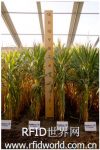
Monsanto test uses RFID tags to track seed packets
[ad_1]
Monsanto, an international provider of bioengineered agricultural products, plans to carry out an RFID technology evaluation test, using passive RFID tags to identify each seed packet shipped from the Agracetus R&D center to the experimental farm (testing genetically modified seeds).
According to Monsanto IT expert Patrick Richgels, the goal of RFID testing is to determine whether replacing the existing barcode system with electronic tags will significantly reduce the time required to transport each box of seeds to the farm.
Richgels conducted a feasibility study in cooperation with the RFID laboratory of the University of Wisconsin. In the study, Richgels and laboratory members used two tags: a high-frequency tag that meets the ISO 15693 standard and an UHF tag that meets the EPC Gen 2 standard to test the reading of the two tags for densely packed seed packets.
The container shipped by Agracetus to the experimental farm is 16 inches wide and 24 inches long, and can hold up to 235 seed packets. The key to how to read a single package is the labeled seed package in the cargo box. The results of the feasibility test are encouraging, so Richgels planned the aforementioned Agracetus pilot project, which is expected to start in January 2008 and last for 6 months.
During the test, the Richgels team manually affixed the RFID tags to the seed packets shipped to the experimental field. The serial number of the RFID tag is printed on the surface of the label in the form of bar code and numbers. In order to confirm the variety of seeds, the test team placed the boxes in front of the fixed reader, and read the seed packets in the boxes one by one; then recorded the time spent reading all the serial codes. In the experimental field, the staff manually received the delivered seed packets and used a barcode scanner to collect the ID numbers of the seed packets.

Monsanto Experimental Field
“After the test, if the results meet our expectations, we will install RFID reading stations in each experimental field.” Richgels said. During the test period, Agracetus participants will benefit from faster transportation; if RFID tags are also read in the experimental field, the process of receiving seeds will also be greatly accelerated.
In addition, Richgels hopes to use RFID tags to count and locate the labeled seeds in Agracetus and experimental fields. In preparation for this test, Richgels and system integrators Miles Technology and Avery Dennison Atlanta Technology Center collaborated to select hardware and software.
Like the evaluation test in the laboratory, Richgels will use both high-frequency and UHF passive tags to evaluate the performance of both. Because high-frequency tags are considered to have better performance and faster reading speeds than UHF tags, Richgels said that when multiple tags are placed next to each other, he believes that HF tags will win. However, the laboratory feasibility test results are not This result is not reflected. “I thought HF has a clear advantage over UFH, but tests show that the gap between the two is very small.” Richgels said.
A large number of HF tags can be read faster than the same amount of UHF tags, but Richgels said speed is not the key to this application. “For us, it doesn’t make much difference whether it takes 5 seconds or 20 seconds to read a box of seed packets,” he said. The second or 20 seconds is a huge improvement.”
[ad_2]




